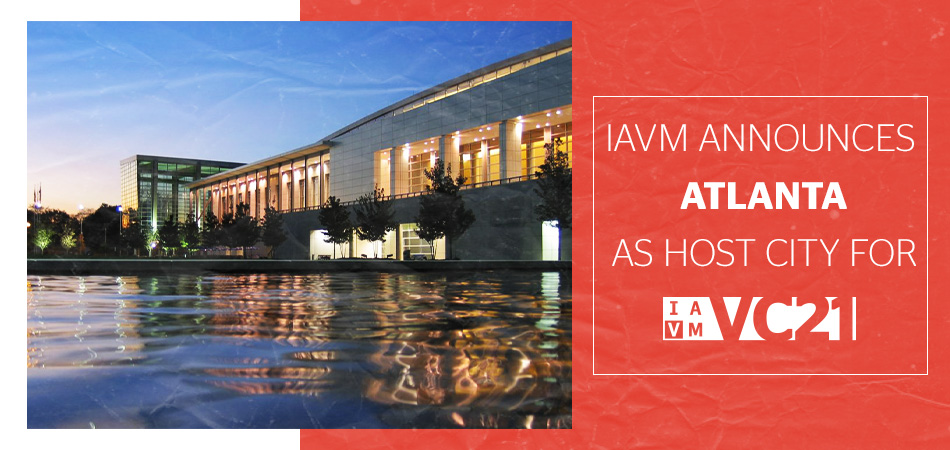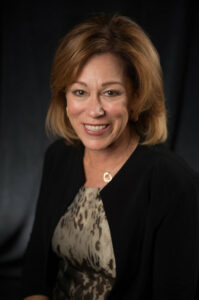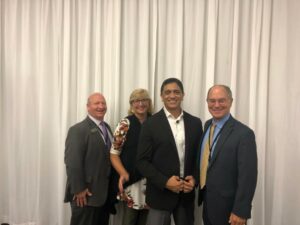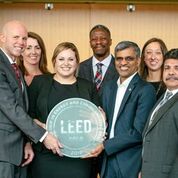FINAL NOTICE – PLEASE SUBMIT APPLICATIONS FOR 2nd VICE CHAIR BY NOVEMBER 1, 2019
The IAVM Leadership Development Committee is seeking candidates who are well-versed in all areas of venue management, invested in their own professional growth and the growth of others, are dedicated to the advancement of the venue industry as a whole and have the demonstrated ability to lead the Association.
The application process and criteria are available here. The deadline to submit your application to Rosanne Duke, Director of Governance/Operations, is November 1, 2019. Minimum Qualifications:
- Must have attained CVE designation and maintain the designation throughout the term of office;
- Must be a dues-paying (either Individual or Group Membership) , Professional Member of IAVM and remain as such throughout the term of office;
- Must have previously served at least one full term on the IAVM Board of Directors;
- Must have served at least one full year as Chair of:
- an IAVM Committee,
- the Board of Regents,
- the Board of Governors, or
- the IAVM Foundation Board of Trustees;
- Must have served on at least 3 of the following in any combination (each Committee service counts as one):
-
- IAVM Committees,
- Board of Regents,
- Board of Governors, or
- Board of Trustees;
- Must have been employed in one of the 2 top positions in a venue for at least 10 years;
- Must have completed at least 1 of the following IAVM school programs:
-
- Venue Management School
- Graduate Institute
- Senior Executive Symposium
- Academy for Venue Safety & Security
-
- Must have attended VenueConnect at least 3 times, and any combination of at least 3 other programs (from the list below) in the previous 6 years:
- Additional years at VenueConnect;
- Other IAVM educational programs; (GuestX, Operations Summit)
- Sector Conferences (AMC, ICCC, PAMC, ISMC, UVMC)
- Region Meetings
- Chapter Meetings
The nomination process is Member-initiated. The web site directs the interested members to review the criteria and utilize the online self-assessment tool to help determine their individual eligibility as a candidate for senior officer, and to ultimately submit an application form should they wish to be considered as a candidate.
IAVM Announces Atlanta as Host Location for VenueConnect 2021

The International Association of Venue Managers (IAVM) is pleased to announce that it will hold the 2021 (August 3-5) VenueConnect Annual Conference & Trade Show in Atlanta, Georgia at Georgia World Congress Center. IAVM’s VenueConnect is the leading industry conference that provides targeted education created specifically for more than 2,000 arena, stadium, convention center, performing arts center, amphitheater & fairgrounds, and college & university venue professionals.
VenueConnect 2021 will bring the conference and trade show back to Atlanta for the first time since 2002. Georgia World Congress Center Authority’s (GWCCA) ever-evolving campus spans 220-plus acres and includes Centennial Olympic Park, the lasting legacy of the 1996 Summer Olympic Games, Mercedes-Benz Stadium, home of the Atlanta Falcons and Atlanta United, and opening in 2022, GWCCA’s headquarter hotel Signia Hilton.
GWCCA, a self-sustained state agency, is entrusted as stewards of these state-owned assets, and has invested more than $360 million over the last decade to improve connectivity between its facilities and downtown Atlanta’s surrounding hospitality district.
“IAVM is excited to bring VenueConnect 2021 to Atlanta,” said Brad Mayne, CVE, IAVM CEO and President. “The GWCCA offers unique backdrops to the VenueConnect experience, but also access to the communities and venues that the Association serves for our attendees. Georgia World Congress Center will provide unique opportunities for our attendees to learn and network.”
Atlanta will provide the perfect setting for attendees from all sectors, and GWCCA provides quick access. From State Farm Arena, home to the NBA’s Atlanta Hawks, the Fox Theatre, College Football Hall of Fame, Center for Civil and Human Rights, CNN Studio Tours and more, conference participants will have many historic and cultural venue options to explore.
More information regarding VenueConnect 2021 will be announced at a later time at www.iavm.org.
About IAVM: Representing public assembly venues from around the globe, IAVM’s 6,800+ active members include managers and senior executives from auditoriums, arenas, convention centers, exhibit halls, stadiums, performing arts centers, university complexes, racetracks, and amphitheaters. IAVM’s mission is to educate, advocate for, and inspire public assembly venue professionals worldwide. More information about IAVM is available at www.IAVM.org or via @IAVMWHQ on Twitter.
Co-Founder and Industry Icon Jane Kleinberger to Retire from Paciolan
From Paciolan news release
Paciolan has announced that Jane Kleinberger will retire from the company she co-founded after nearly four decades.
Since founding Paciolan in 1980, Kleinberger helped grow the company into the second-largest primary ticketing  solution provider in North America. Today, Paciolan is a force in ticketing as the largest provider in college athletics, with over 135 clients, along with a large footprint in arenas, professional sports, and performing arts.
solution provider in North America. Today, Paciolan is a force in ticketing as the largest provider in college athletics, with over 135 clients, along with a large footprint in arenas, professional sports, and performing arts.
Kleinberger was the first female CEO of a major ticketing company, and her strong legacy is upheld today by President and CEO, Kim Damron, along with CFO, Kim Boren, and many other talented female leaders at Paciolan.
Kleinberger has long been a ticketing industry icon. She served as a board member and eventual chairperson for the International Ticketing Association (INTIX), worked as a member and active participant of the International Association of Venue Managers (IAVM), was a regular guest lecturer on the university circuit and worked closely with many other industry organizations throughout her career.
The recipient of several prestigious industry awards, Kleinberger was recognized in the inaugural class of Sports Business Journal Game Changers, and she received IAVM’s Joseph J. Anzivino Distinguished Allied Award, the Venues Now Woman of Influence Award and the Patricia G. Spira Lifetime Achievement Award from INTIX.
“Jane has been an inspiration as a founder and leader in the ticketing industry and we are grateful for all of her accomplishments,” Damron said. “Her vision and perseverance helped grow Paciolan into the thriving business that it is today by forging long-term relationships with clients and our community.”
Paciolan was the first ticketing company to introduce the “venue enablement model” providing teams and venues with the ability to sell directly to customers under their own brand. This model continues to grow as a strong opportunity for live entertainment organizations to increase revenue and build lifetime customer relationships.
“I’ve known Jane for my entire career and her passion and vision is what brought me to Paciolan over 16 years ago,” said Steve Demots, CRO of Paciolan. “It has been an honor working alongside her to help grow the business.”
Although she is retiring from the advisory role that she held for the past two years at Paciolan, Jane plans to stay close to the live entertainment space, look for opportunities to give back, and provide guidance to the next generation of entrepreneurs.
“I am so very proud of what Paciolan has become and the exceptional team of diverse leaders that continue to drive it forward,” Kleinberger said. “It has been my privilege to work with them as well as so many wonderful clients and friends in this industry that means so much to me.”
Allen County War Memorial Coliseum Holds IAVM Situational Awareness Training
By Michele Remenschneider
As part of our annual All Employees Meeting, the Allen County War Memorial Coliseum invited IAVM Director of Education Mark Herrera to talk to our staff members. When we were in the planning stages Mr. Herrera suggested we could include some of our local venue partners to join in on the training.
We ended up holding two training sessions. The first one included members of our local law enforcement agencies,  sports teams, local theatres, our zoo, airport, and others involved in putting on events. We were excited to host the gathering of colleagues. The training was well received and provided a platform to share contact information and resources.
sports teams, local theatres, our zoo, airport, and others involved in putting on events. We were excited to host the gathering of colleagues. The training was well received and provided a platform to share contact information and resources.
Our annual meeting was attended by all of our staff as part of our gearing up for the busy time of year. Mark did the Situational Awareness training and once again it was a huge win. His ability to relate to the crowd, share his experiences, as well as provide tips and best practices for providing a safe environment was a great training opportunity. I know our awareness level was raised and we are better equipped to see something, say something and especially do something!
Mark trained nearly 400 people during his time in Fort Wayne. Our building is truly grateful to Mark and the IAVM for their commitment to education, training, and safety.
Michele Remenschneider is vice president of event services for Allen County War Memorial Stadium in Fort Wayne, Indiana.
TCF Center Becomes the Largest LEED Certified Building in Michigan
By Mary Klida
Claude Molinari, general manager of ASM Global/TCF Center, announced that TCF Center has been awarded LEED Gold Certification. The LEED (Leadership in Energy and Environmental Design) rating system, developed by the U.S. Green Building Council (USGBC), is the foremost program for buildings, homes and communities that are designed, constructed, maintained and operated for improved environmental and human health performance. With 2.4 million square feet in the venue, TCF Center becomes the largest LEED certified building in the state of Michigan.
The certification plaque was presented to Molinari in a ceremony at TCF Center by Mahesh Ramanujam, president and CEO, USGBC.
“LEED is a transformative tool that is helping communities build spaces that are not only better for the  environment, but for people too,” Ramanujam said. “By prioritizing sustainability, TCF Center is leading the way in its industry. It is moving beyond construction and efficiency and finding ways to help us improve our quality of life by creating spaces that prioritize health and well-being.”
environment, but for people too,” Ramanujam said. “By prioritizing sustainability, TCF Center is leading the way in its industry. It is moving beyond construction and efficiency and finding ways to help us improve our quality of life by creating spaces that prioritize health and well-being.”
TCF Center opened as the largest convention center in the United States in 1960 and underwent a major renovation in 1989. Its Green Committee was formed in 2011 with members from every administrative department and vendor company in the building, obtaining the venue’s green certifications and developing sustainable operations. The facility’s most recent $279 million renovation in 2015 included significant upgrades in energy HVAC saving equipment, water saving fixtures, and a living green roof. With a grant from the Smart Buildings Detroit Energy Conservation Program, the venue also installed overall energy reduction enhancements. Those include $9.9 million in insulation, computerized mechanical and lighting controls, induction lighting in all exhibit halls, enclosed loading docks and energy efficient escalators.
“We continue to make strides in improving the sustainability of our offerings,” Molinari said. “Receiving our LEED Gold Certification signals that our venue is truly world-class with all of the benefits a sustainable environment offers.”
The ongoing improvements in sustainable operations over the years at TCF Center got the attention of some of the event industry’s most influential trade shows that promote global environmentalism such as Sustainable Brands, an association of global brand leaders shaping the future of commerce. It held its first event at TCF Center in 2017 where it recorded a 92 percent waste diversion rate. Sustainable Brands once again selected TCF Center for its SB’19 Conference because of the venue’s commitment to sustainability and efforts in encouraging suppliers to follow best practices. The conference held June 4-6 2019 achieved zero waste status by recording a 100 percent diversion rate.
“TCF Center’s commitment to sustainability and reducing its environmental impact was an important factor in why we wanted to bring our global event to Detroit. We are excited to hear about TCF Center’s new LEED certification and hope that this will help attract similar events to Detroit and to TCF Center,” said David Fiss, director business development, partnerships and event strategy for Sustainable Brands.
TCF Center was recognized by LEED for several best practices resulting in the certification. High efficiency of having 1,200 parking spaces on the roof top was noted, along with the reflective surfaces of the roof and the venue’s Living Green Roof. Efficiency of water use was highly rated as was the venue’s sustainability marketing efforts with specific credit to the “Sustainability Lives Here” campaign designed by Detroit-based Lovio George Communications.
LEED is the most widely used green building rating system and a symbol of international excellence. Green buildings allow venues like TCF Center to operate more sustainably and provide a healthier, more comfortable space for people to enjoy. More than 98,500 commercial and institutional projects are currently participating in LEED, comprising more than 21 billion square feet of construction space in all 50 states and more than 175 countries and territories. There are 213 LEED certified buildings in the Metro Detroit area.
“TCF Center has actively been working to push the needle on sustainable operations since 2011,” said Joel Howrani Heeres, director, Office of Sustainability for the City of Detroit. “This LEED Gold certification recognizes their efforts to reduce their environmental impact while still being a leader in the tourism and events industry. TCF Center serves as an excellent example to other building owners in Detroit. The changes they’ve made to both their operations and organizational culture will help the city as it moves towards a future as a sustainable and resilient city.”
Mary Klida is senior marketing & communications manager at TCF Center, formerly Cobo Center.
Do you want to receive a Front Row News weekly digest?
Categories
- Allied (861)
- Architecture (147)
- Arenas (747)
- Career (897)
- Convention Centers (895)
- Education (623)
- Events (1,544)
- Food & Beverage (193)
- Foundation (113)
- Guest Experience (1,496)
- Industry News (2,270)
- Leadership (1,888)
- Marketing (150)
- Membership (2,000)
- Music (213)
- Performing Arts Centers (454)
- Professional Development (409)
- Research (127)
- Safety & Security (442)
- Sports (763)
- Stadiums (608)
- Student (159)
- Technology (516)
- Ticketing (92)
- Touring (82)
- Trends (364)
- Uncategorized (741)
- Universities (218)
- Video (25)
- Young Professional (198)
Twitter Feed
- Twitter feed loading
Recent Posts
- Peggy Daidakis Humbly Made Convention Center History
- Welcome to Our Newest Members
- New Member Benefit! IAVM Partners with Advantage Training to Elevate Staff Readiness and Guest Experience
- Charlotte Convention Center Welcomes Two New Leaders to its Management Team
- Fort Worth Cuts Ribbon on Phase 1 of Convention Center Expansion
Categories
- Allied
- Architecture
- Arenas
- Career
- Convention Centers
- Education
- Events
- Food & Beverage
- Foundation
- Guest Experience
- Industry News
- Leadership
- Marketing
- Membership
- Music
- Performing Arts Centers
- Professional Development
- Research
- Safety & Security
- Sports
- Stadiums
- Student
- Technology
- Ticketing
- Touring
- Trends
- Uncategorized
- Universities
- Video
- Young Professional
Archives
- December 2025
- November 2025
- October 2025
- September 2025
- August 2025
- July 2025
- June 2025
- May 2025
- April 2025
- March 2025
- February 2025
- January 2025
- December 2024
- November 2024
- October 2024
- September 2024
- August 2024
- July 2024
- June 2024
- May 2024
- April 2024
- March 2024
- February 2024
- January 2024
- December 2023
- November 2023
- October 2023
- September 2023
- August 2023
- July 2023
- June 2023
- May 2023
- April 2023
- March 2023
- February 2023
- January 2023
- December 2022
- November 2022
- October 2022
- September 2022
- August 2022
- July 2022
- June 2022
- May 2022
- April 2022
- March 2022
- February 2022
- January 2022
- December 2021
- November 2021
- October 2021
- September 2021
- August 2021
- July 2021
- June 2021
- May 2021
- April 2021
- March 2021
- February 2021
- January 2021
- December 2020
- November 2020
- October 2020
- September 2020
- August 2020
- July 2020
- June 2020
- May 2020
- April 2020
- March 2020
- February 2020
- January 2020
- December 2019
- November 2019
- October 2019
- September 2019
- August 2019
- July 2019
- June 2019
- May 2019
- April 2019
- March 2019
- February 2019
- January 2019
- December 2018
- November 2018
- October 2018
- September 2018
- August 2018
- July 2018
- June 2018
- May 2018
- April 2018
- March 2018
- February 2018
- January 2018
- December 2017
- November 2017
- October 2017
- September 2017
- August 2017
- July 2017
- June 2017
- May 2017
- April 2017
- March 2017
- February 2017
- January 2017
- December 2016
- November 2016
- October 2016
- September 2016
- August 2016
- July 2016
- June 2016
- May 2016
- April 2016
- March 2016
- February 2016
- January 2016
- December 2015
- November 2015
- October 2015
- September 2015
- August 2015
- July 2015
- June 2015
- May 2015
- April 2015
- March 2015
- February 2015
- January 2015
- December 2014
- November 2014
- October 2014
- September 2014
- August 2014
- July 2014
- June 2014
- May 2014
- April 2014
- March 2014
- February 2014
- January 2014
- December 2013
- November 2013
- October 2013
- September 2013
- August 2013
- July 2013
- June 2013
- May 2013
- April 2013
- March 2013
- February 2013
- January 2013
- May 2012
- March 2012
- December 2011
- November 2011
- October 2011
Recent Comments
- Frank Bradshaw, Ph.D., CVE on John Meyer, CVE, a Tireless Advocate of Certification for Venue Professionals, Has Died
- Neil Sulkes on Hilary Hartung, Friend to Many in Venue Marketing, Has Left Us
- Jason Parker, CVE on The Devastation of Hurricane Helene and How We Can Support One Another
- Larry Perkins on Touhey Testifies Against Speculative Ticketing Before Congressional Subcommittee
- Peter Secord on Major Players for Planned Elkhart Amphitheater Were in the Mix at VenueConnect
